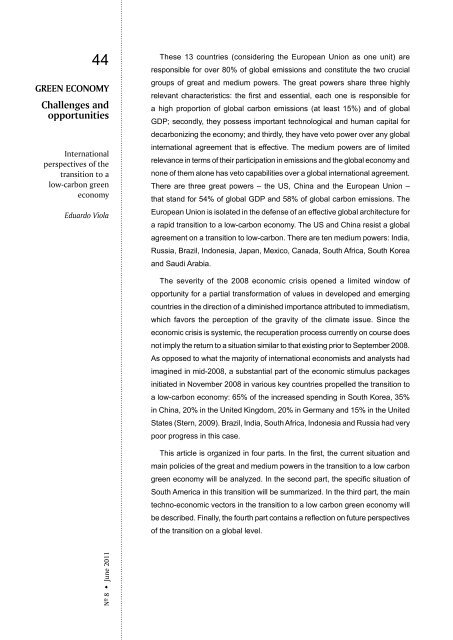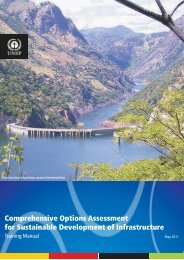Download Publication - Rio+20
Download Publication - Rio+20
Download Publication - Rio+20
Create successful ePaper yourself
Turn your PDF publications into a flip-book with our unique Google optimized e-Paper software.
44<br />
GREEN ECONOMY<br />
Challenges and<br />
opportunities<br />
International<br />
perspectives of the<br />
transition to a<br />
low-carbon green<br />
economy<br />
Eduardo Viola<br />
These 13 countries (considering the European Union as one unit) are<br />
responsible for over 80% of global emissions and constitute the two crucial<br />
groups of great and medium powers. The great powers share three highly<br />
relevant characteristics: the first and essential, each one is responsible for<br />
a high proportion of global carbon emissions (at least 15%) and of global<br />
GDP; secondly, they possess important technological and human capital for<br />
decarbonizing the economy; and thirdly, they have veto power over any global<br />
international agreement that is effective. The medium powers are of limited<br />
relevance in terms of their participation in emissions and the global economy and<br />
none of them alone has veto capabilities over a global international agreement.<br />
There are three great powers – the US, China and the European Union –<br />
that stand for 54% of global GDP and 58% of global carbon emissions. The<br />
European Union is isolated in the defense of an effective global architecture for<br />
a rapid transition to a low-carbon economy. The US and China resist a global<br />
agreement on a transition to low-carbon. There are ten medium powers: India,<br />
Russia, Brazil, Indonesia, Japan, Mexico, Canada, South Africa, South Korea<br />
and Saudi Arabia.<br />
The severity of the 2008 economic crisis opened a limited window of<br />
opportunity for a partial transformation of values in developed and emerging<br />
countries in the direction of a diminished importance attributed to immediatism,<br />
which favors the perception of the gravity of the climate issue. Since the<br />
economic crisis is systemic, the recuperation process currently on course does<br />
not imply the return to a situation similar to that existing prior to September 2008.<br />
As opposed to what the majority of international economists and analysts had<br />
imagined in mid-2008, a substantial part of the economic stimulus packages<br />
initiated in November 2008 in various key countries propelled the transition to<br />
a low-carbon economy: 65% of the increased spending in South Korea, 35%<br />
in China, 20% in the United Kingdom, 20% in Germany and 15% in the United<br />
States (Stern, 2009). Brazil, India, South Africa, Indonesia and Russia had very<br />
poor progress in this case.<br />
This article is organized in four parts. In the first, the current situation and<br />
main policies of the great and medium powers in the transition to a low carbon<br />
green economy will be analyzed. In the second part, the specific situation of<br />
South America in this transition will be summarized. In the third part, the main<br />
techno-economic vectors in the transition to a low carbon green economy will<br />
be described. Finally, the fourth part contains a reflection on future perspectives<br />
of the transition on a global level.<br />
Nº 8 • June 2011

















